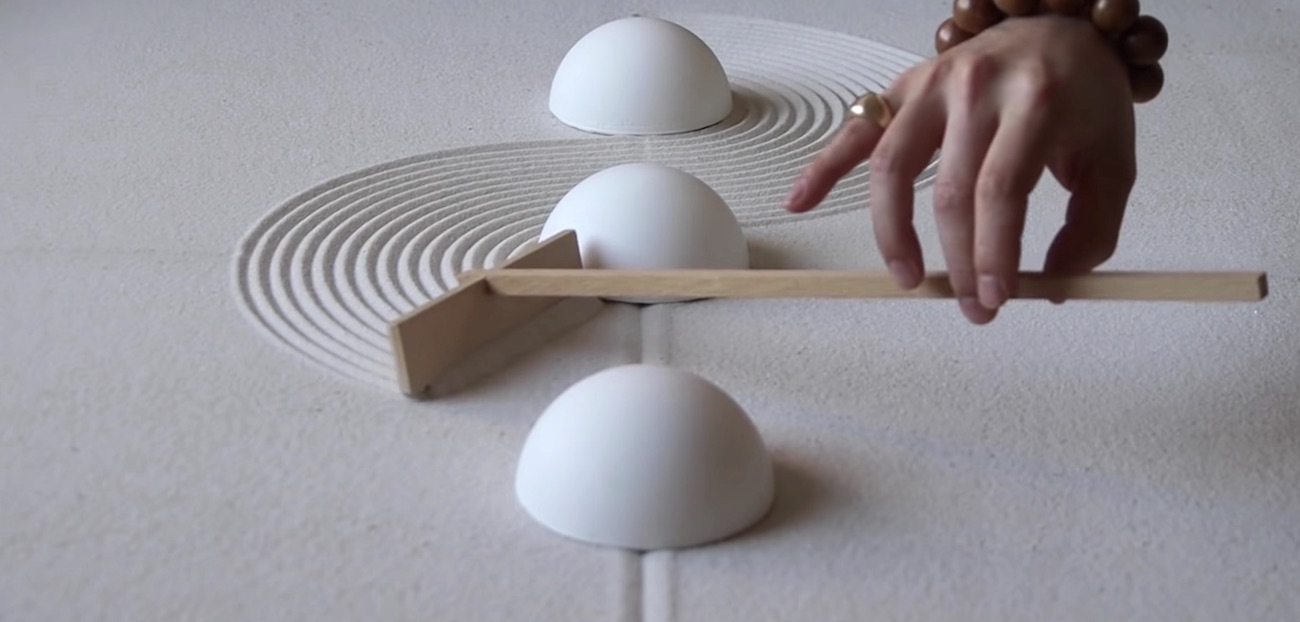Marici — “Ray of Light” Bodhisattva Goddess — protective Bodhisattva for “turbulent times”; aspect of glorious Mother Tara: includes Dharani mantra
Marici’s most popular praise, written by the great Vidyadhara Jigdral Lingpa, states her most important role is “to bring protection from fear in these turbulent times.”[1] The turbulent times referred to was centuries ago, and sadly, we still need...
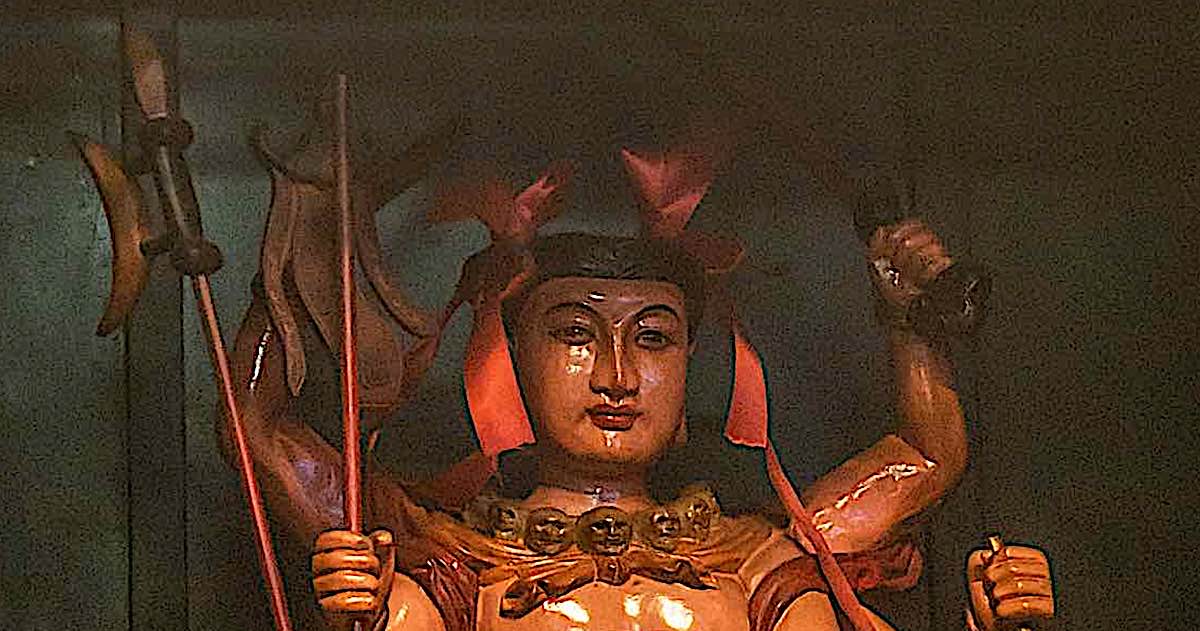
Marici’s most popular praise, written by the great Vidyadhara Jigdral Lingpa, states her most important role is “to bring protection from fear in these turbulent times.”[1]
The turbulent times referred to was centuries ago, and sadly, we still need the powerful protection of Marici, the emanation of Tara. Her Dharani, most effective in these difficult times, was proclaimed by Shakyamuni Buddha [full text below “Dharani of Marica, spoken by the Buddha”] [2]
Marici, the ray of light, the glorious Bodhisattva Goddess of compassion who rides a boar, is an aspect of Tara in most Tibetan traditions. She is revealed as the 21st Tara in some Nyingma traditions. In the Surya Gupta tradition she is the attendant of the 9th Tara along with Ekajati (in this context they are considered aspects of Tara.)
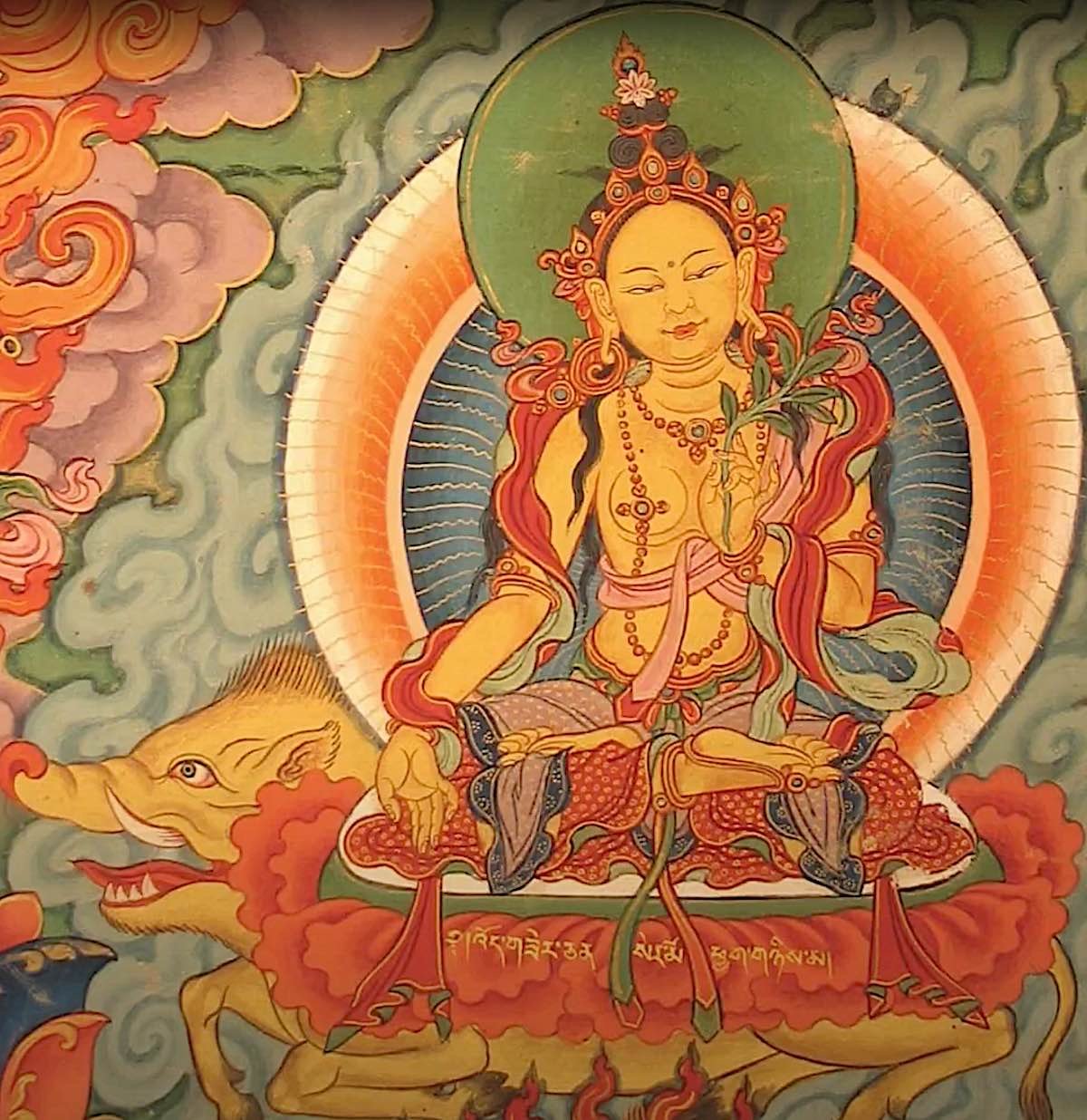 Marici Goddess of the Dawn is the “enemy of the Maras” and an important Mahayana and Vajrayana Enlightened Deity, an aspect of Tara. Himalayan Art Project image (see video below.)
Marici Goddess of the Dawn is the “enemy of the Maras” and an important Mahayana and Vajrayana Enlightened Deity, an aspect of Tara. Himalayan Art Project image (see video below.)
Great enemy of the Maras
She is called the “great enemy of the Maras” — due to her well-known protective role. In this beautiful Tibetan praise, her protective aspects are acclaimed — by the vidyādhara Jigdral Lingpa:
ཨོཾ་ལྷ་མོ་འོད་ཟེར་ཅན་མ་ལ་ཕྱག་འཚལ་ལོ། །
om, lhamo özer chenma la chaktsal lo
Oṃ! Homage to the goddess Mārīcī!
ཕྱག་འཚལ་བདུད་ཀྱི་བདུད་དགྲ་ཆེན་མོ། །
chaktsal dü kyi dü dra chenmo
Homage to her, the great enemy of the māras!
གཞན་གྱིས་མི་ཐུབ་རྣམ་པར་འཇོམས་མ། །
zhen gyi mitub nampar jomma
Utterly invincible, vanquisher of all,
ཉི་མ་ཟླ་བའི་མདུན་ནས་འགྲོ་ཞིང༌། །
nyima dawé dün né dro zhing
She who travels before the sun and moon,
ཆུ་སྲིན་རྒྱལ་མཚན་རྣམ་པར་སྐྲོད་མ། །
chusin gyaltsen nampar tröma
And drives away Makaradhvaja, God of Desire—
ཁྱོད་ལ་གསོལ་བ་བཏབ་པ་ཙམ་གྱིས། །
khyö la solwa tabpa tsam gyi
Simply by praying to you,
དགྲ་ཡི་དཔུང་ནི་རྣམ་པར་ཆོམས་ཤིག །
dra yi pung ni nampar chom shik
May the hosts of opposing forces be destroyed!
བསད་དང་དབྱེ་དང་བསྐྲད་རྨོངས་བྱེར་བས། །
sé dang yé dang tré mong jerwé
Slay them, divide them, drive them away, confuse them and disperse them,
ཕྱོགས་ལས་རྣམ་རྒྱལ་དངོས་གྲུབ་སྩོལ་ཅིག །
chok lé namgyal ngödrub tsol chik
And grant us the siddhi of total victory over all adversity!
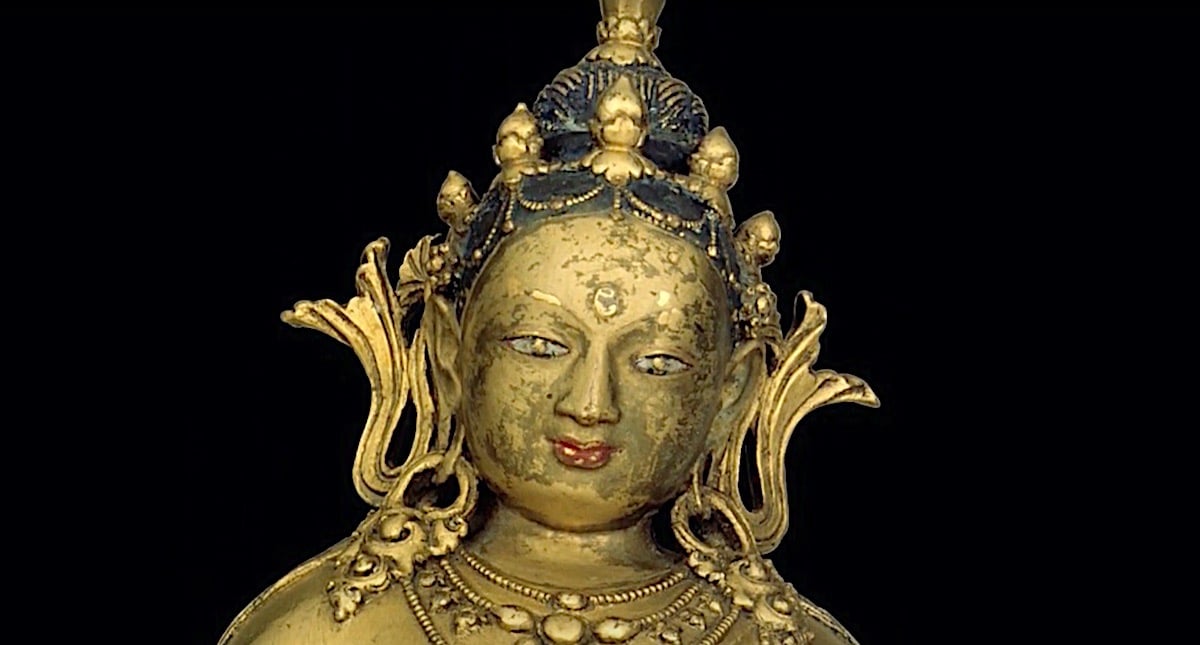 Marici Goddess of the Dawn is an important Mahayana and Vajrayana Enlightened Deity, an aspect of Tara. Himalayan Art Project image (see video below.)
Marici Goddess of the Dawn is an important Mahayana and Vajrayana Enlightened Deity, an aspect of Tara. Himalayan Art Project image (see video below.)
Ray of Light — shining light of protection
Mārīcī (Sanskrit: मारीची, lit. “Ray of Light”; Chinese: 摩利支天; pinyin: Mólìzhītiān; Japanese: Marishiten), is a Buddhist Devi or Enlightened goddess, as well as a bodhisattva associated with light and the Sun. She is typically depicted with multiple arms and riding a charging boar or sow, or on a fiery chariot pulled by seven horses or seven boars. She has either one head, or between three to six with one shaped like a boar. In parts of East Asia, in her fiercest forms, she may wear a necklace of skulls. In some representations, she sits upon a lotus flower.
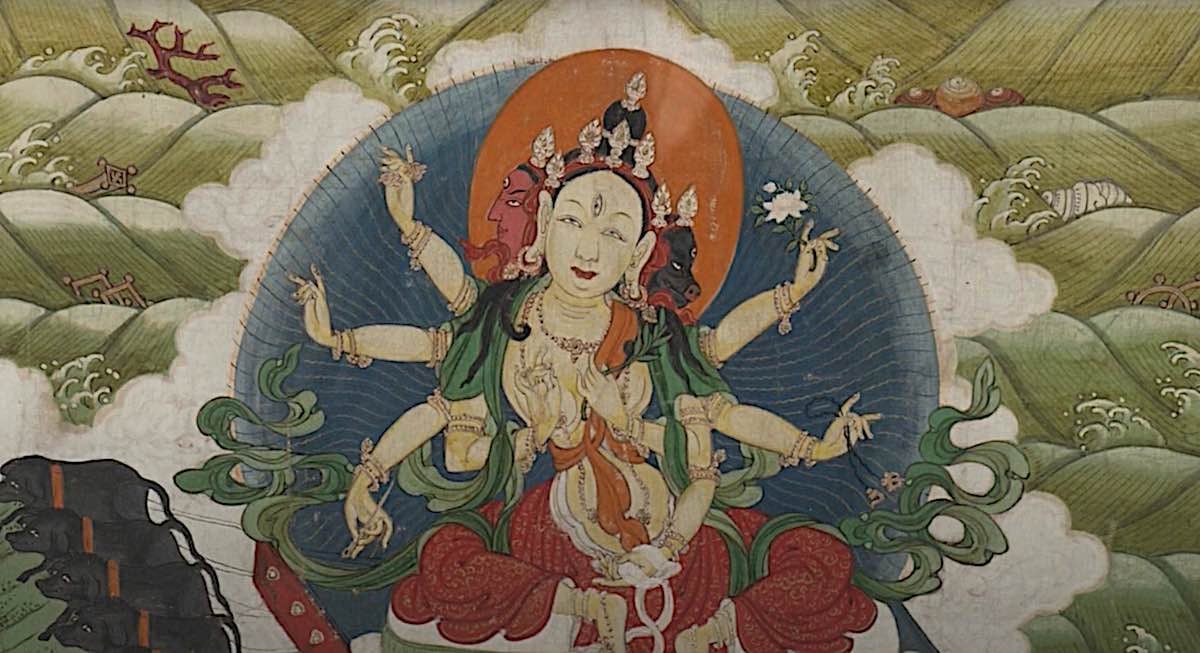 Marici Goddess of the Dawn is an important Mahayana and Vajrayana Enlightened Deity, an aspect of Tara. Himalayan Art Project image (see video below.)
Marici Goddess of the Dawn is an important Mahayana and Vajrayana Enlightened Deity, an aspect of Tara. Himalayan Art Project image (see video below.)
Mārīcī is popular in Japan, China, Korea, Tibet, Nepal, Sri Lanka and Vietnam. In Japan she is also known as Bari Kannon (摩利観音). In China she is also known as Moli Tian or Boli Tian. In Korea she is also known as Bulmujongwon-bosal.
In the Dharani sutra of Marici, her benefits are recited by the Buddha [for the full text, including Sanskrit of this Dharani, see section below]:
“Oṃ, goddess Mārīcī, please protect me on the road!
Please protect me from taking wrong paths!
Please protect me from dangerous beings!
Please protect me from the danger of tyrants!
Please protect me from the danger of elephants!
Please protect me from the danger of thieves!
Please protect me from the danger of nāgas!
Please protect me from the danger of lions!
Please protect me from the danger of tigers!
Please protect me from the danger of fire!
Please protect me from the danger of water!
Please protect me from the danger of snakes!
Please protect me from the danger of poison!
Please protect me from the danger of opponents and adversaries!”
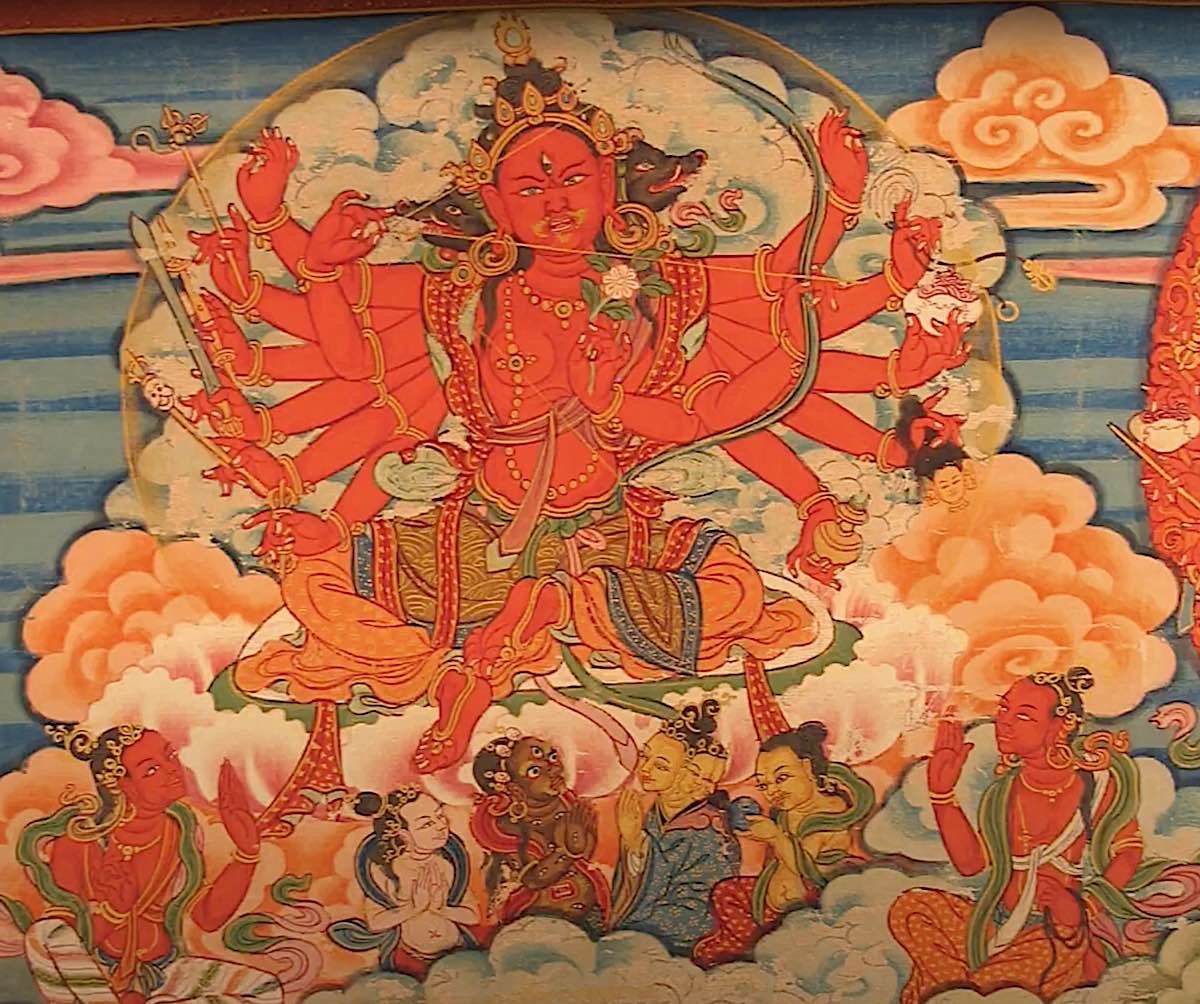 A more wrathful version of Marici. Marici is the “enemy of the Maras” and protects from many dangers.
A more wrathful version of Marici. Marici is the “enemy of the Maras” and protects from many dangers.
This is followed by her special Dharani of protection, spoken by Shakyamuni Buddha:
tadyathā | oṃ vattālī vadālī varālī varāha-mukhī | sarva-duṣṭa-pra-duṣṭānāṃ cakṣur-mukhaṃ bandha bandha | bandha mukhaṃ jambhaya stambhaya mohaya svāhā | oṃ mārīcyai svāhā | oṃ varālī vadālī vattālī varāha-mukhī sarva-duṣṭa-pra-duṣṭānāṃ cakṣur-mukhaṃ bandha bandha svāhā ||
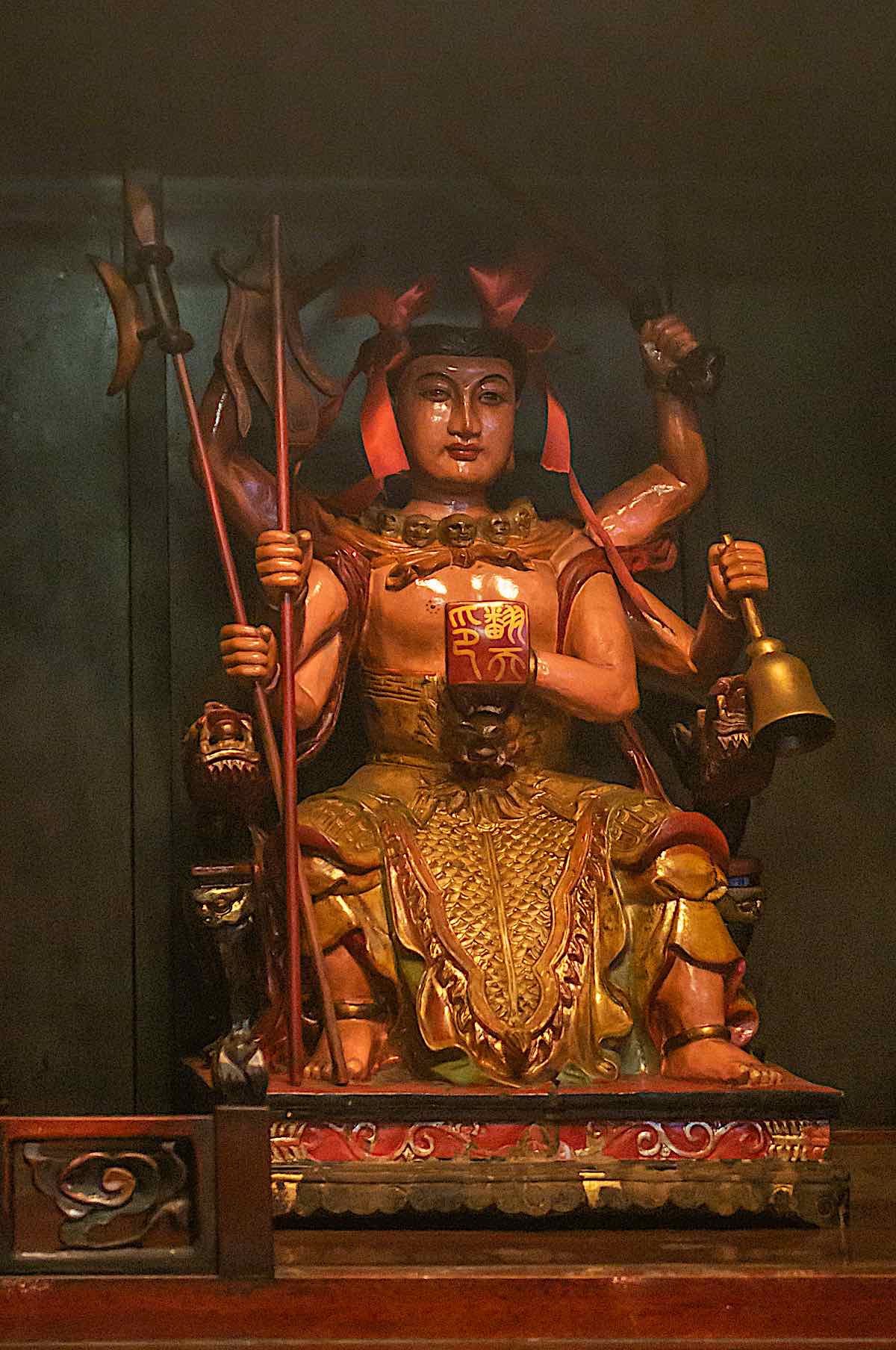 Marici statue in Hong Kong.
Marici statue in Hong Kong.
Marici’s Special Place in the Shingon School
Mārīcī has a special place in the Shingon school of Japanese Buddhism, which arose during the Heian period (794–1185). This was due to the efforts of Kūkai, who brought back teachings and artifacts from his travels to China. The school sees her as a manifestation of Dainichi Nyorai, the central Buddha in their belief system. In this tradition, Mārīcī is seen as a saviouress who can save beings from the sufferings of illness, old age, and death.
The Shingon school also teaches that reciting her mantra can help one be reborn in her Pure Land.
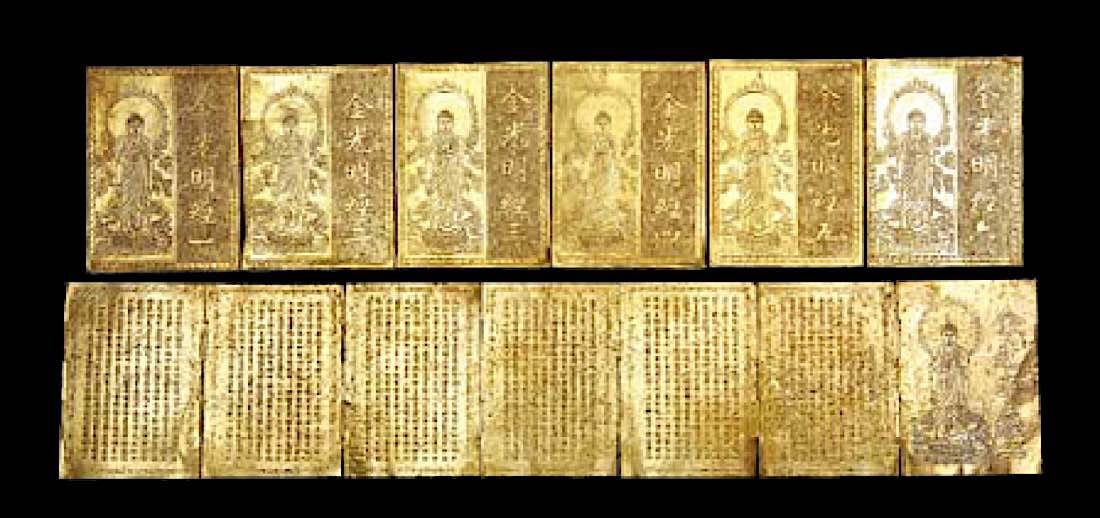 Golden Light Sutra.
Golden Light Sutra.
Sutra of Golden Light
Mārīcī is also an important figure in the Nara period (710–794) in Buddhist scripture known as the Sutra of Golden Light. In this text, she is said to have been born from a beam of light that emanated from Amida Buddha. She then appears before the Buddha and asks him how she can best help beings attain salvation. The Buddha replies that she should teach them the sutra, which she does.
The Sutra of Golden Light was very popular in Japan during the Heian period, and Mārīcī became one of the most popular deities during this time. She was seen as a protector of the state, and her image was often placed in temples and shrines.
Mārīcī is also known as the Goddess of the Seven Seas in China and Japan. In this capacity, she is said to protect sailors and fishermen from danger.
For a feature on the Golden Light Sutra, see>> A wrathful Marici. Himalayan Art Project.
A wrathful Marici. Himalayan Art Project.
Marici’s many stories
There are many famous stories about Mārīcī in both China and Japan. One story tells of how she saved the life of a drowning child. Another tells of how she helped a poor man find a precious jewel.
Mārīcī is also known as the Goddess of the Harvest in some parts of Asia. In this role, she is said to bring good luck to farmers and to ensure a bountiful harvest.
Mārīcī is also worshipped as a goddess of love and beauty. In this capacity, she is said to bestow upon her worshippers the gift of attractiveness and charm.
Mārīcī is also known as the Goddess of Mercy in some parts of Asia. In this role, she is said to have the power to save beings from suffering and misfortune.
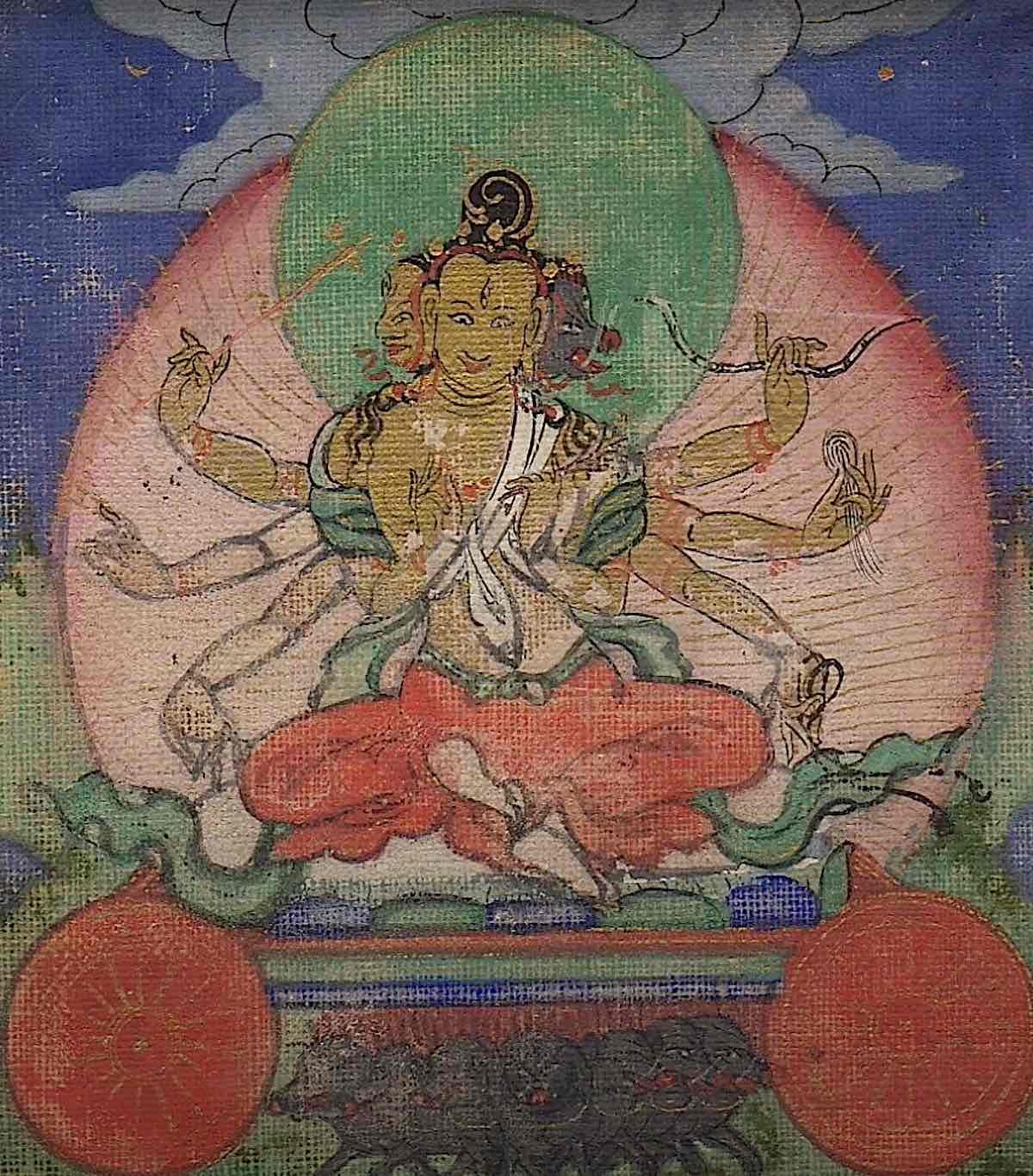 There are many stories of Marici’s rescues.
There are many stories of Marici’s rescues.
There are many temples and shrines dedicated to Mārīcī in Asia. Some of the most famous are the Marici Shrine in Kyoto, Japan; the Daiju-ji Temple in Nara, Japan; the Zu Lai Temple in Brazil; and the Wat Phra Dhammakaya in Thailand.
Mārīcī is also a popular figure in Buddhist art. She is often depicted riding a boar or a sow, or on a fiery chariot pulled by seven horses or seven boars. She may also be shown with multiple arms, and sometimes she is depicted sitting on a lotus flower.
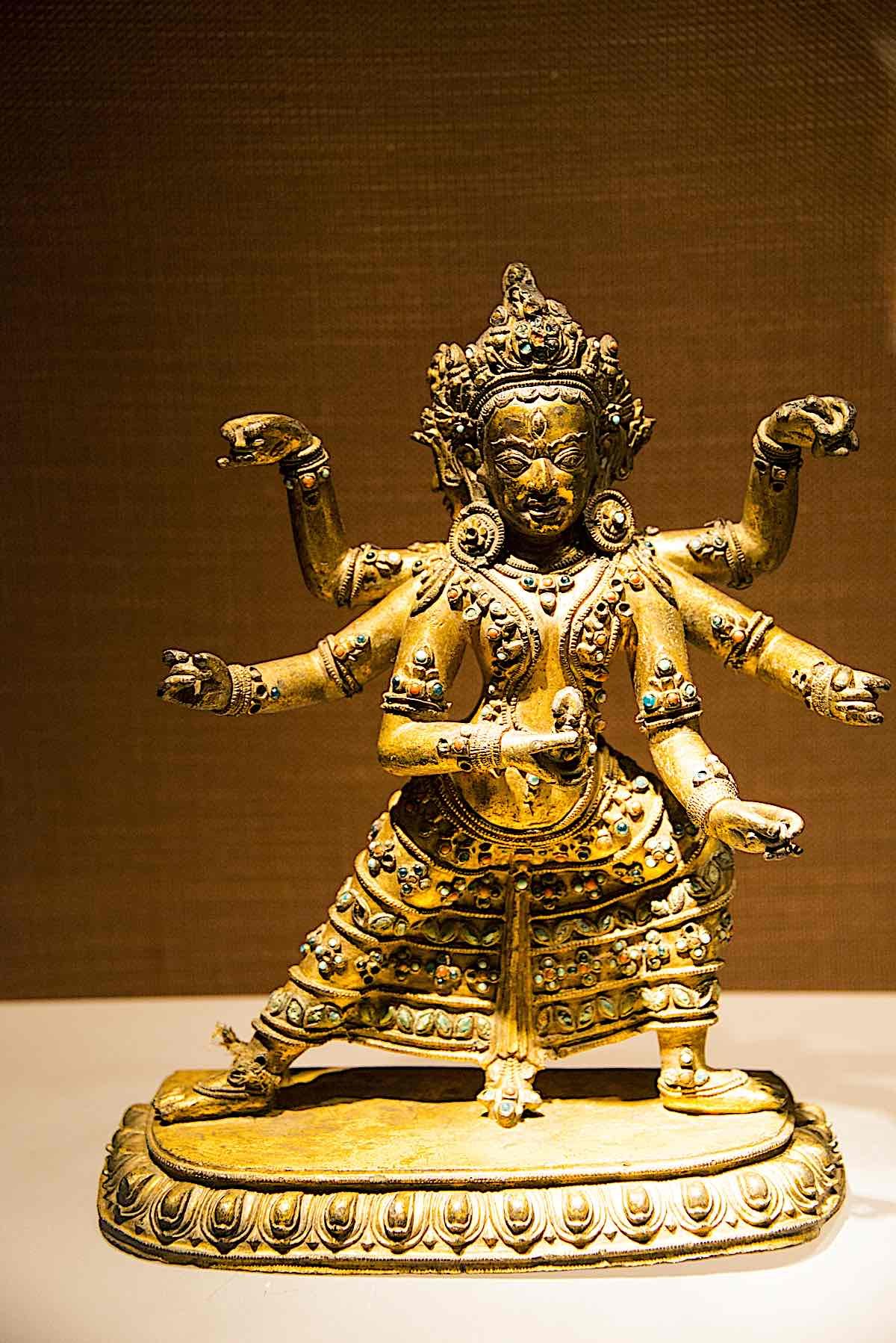 Statue of Marici in Beijing Museum.
Statue of Marici in Beijing Museum.
Mantras associated with Mārīcī
Om mārī ci padme hūṃ (Tibetan)
Om mārī ci namah ( Sanskrit)
Namu mārīcīye ( Japanese)
Homage to Mārīcī ( English)
The Tibetan Marici mantra is: om mare ci padme hung. This translates to “homage to the bestower of rays of light and lotuses.”
Mantras are sacred sounds that are believed to have spiritual power. They are often used in meditation and prayer.
The Marici mantra is used for protection, success, and prosperity. It is also said to grant beauty, charm, and magnetism. The mantra can be recited 108 times per day.
There are many different spellings of Mārīcī, including: Mari, Marici, Mari-ji, Marie-ji, Matangi, and Matangi-ji.
Bari Gyatsa — Five descriptions of Marici
In Tibetan literature, the Bari Gyatsa contains five different descriptions of Mārīcī:
Oḍḍiyāna Mārīcī Kalpa Ukta Mārīcī Kalpa Ukta Vidhinā Sita Mārīcī Aśokakāntā Mārīcī Oḍḍiyāna Krama MārīcīThe Bari Gyatsa is a collection of songs and prayers dedicated to Mārīcī. It was composed by the Tibetan Buddhist master Padmasambhava, who is also known as the Guru Rinpoche.
Mārīcī is also one of the Twenty-One Taras, a popular form of the goddess in Tibetan Buddhism.
Video: Himalayan Art Project’s Documentary on Marici
(Some images in this feature are from this video)
Descriptions of Marici
The Drub Tab Gyatso has six descriptions:
White with five faces and ten hands Yellow with three faces and eight hands Yellow with three faces and eight hands Dharmadhātu Īśvarī, red with six faces and twelve hands Picumī, yellow with three faces and eight hands Red with three faces and twelve handsThis is not a complete list. Marici has many forms.
Mari means “ray of light.” Ci can mean “bestowal,” “emanation,” or “radiance.” Padme means “lotus flower.” Hum is a seed syllable.
Video: Beautiful chanting of Marici’s Dharani:
Dharani of Marici, spoken by the Buddha
༄༅། །འཕགས་མ་འོད་ཟེར་ཅན་ཞེས་བྱ་བའི་གཟུངས་བཞུགས་སོ། །
The Noble Mārīcī Dhāraṇī
from the Words of the Buddha
རྒྱ་གར་སྐད་དུ། ཨཱཪྻ་མཱ་རཱི་ཙྱེ་ནཱ་མ་དྷཱ་ར་ཎཱི།gyagar ké du arya maritsyé nama dharani
In the language of India: Āryamārīcī-nāma-dhāraṇī
བོད་སྐད་དུ། འཕགས་མ་འོད་ཟེར་ཅན་ཞེས་བྱ་བའི་གཟུངས།
böké du pakma özer chen zhejawé zung
In the language of Tibet: Pakma özer chen shé chawé zung (‘phags ma ‘od zer can zhes bya ba’i gzungs)
In the English language: The Noble Incantation of Mārīcī
སངས་རྒྱས་དང་བྱང་ཆུབ་སེམས་དཔའ་ཐམས་ཅད་ལ་ཕྱག་འཚལ་ལོ། །
sangye dang changchub sempa tamché la chaktsal lo
Homage to all the buddhas and bodhisattvas!
འདི་སྐད་བདག་གིས་ཐོས་པ་དུས་གཅིག་ན།
diké dak gi töpa dü chik na
Thus have I heard.
བཅོམ་ལྡན་འདས་མཉན་དུ་ཡོད་པ་ན་རྒྱལ་བུ་རྒྱལ་བྱེད་ཀྱི་ཚལ་མགོན་མེད་ཟས་སྦྱིན་གྱི་ཀུན་དགའ་ར་བ་ན།
chomdendé nyen du yöpa na gyalbu gyal jé kyi tsal gönmé zé jin gyi kün ga rawa na
Once the Blessed One was dwelling in Śrāvastī, in Anāthapiṇḍada’s garden in the Jetavana grove,
དགེ་སློང་གི་དགེ་འདུན་ཆེན་པོ་བརྒྱ་ཕྲག་ཕྱེད་དང་བཅུ་གསུམ་དང༌།
gelong gi gendün chenpo gyatrak ché dang chusum dang
Together with a great gathering of twelve hundred and fifty monks,
བྱང་ཆུབ་སེམས་དཔའ་སེམས་དཔའ་ཆེན་པོ་མང་པོ་དག་དང་ཐབས་ཅིག་ཏུ་བཞུགས་ཏེ།
changchub sempa sempa chenpo mangpo dak dang tab chik tu zhuk té
And a great gathering of many bodhisattva mahāsattvas.
དེ་ནས་བཅོམ་ལྡན་འདས་ཀྱིས་དགེ་སློང་རྣམས་ལ་བཀའ་སྩལ་པ།
dené chomdendé kyi gelong nam la katsal pa
At that time, the Blessed One said to the monks:
དགེ་སློང་དག །ལྷ་མོ་འོད་ཟེར་ཅན་མ་ཞེས་བྱ་བ་ཞིག་ཡོད་དེ།
gelong dak lhamo özer chen ma zhejawa zhik yö dé
“Monks, there is a goddess called Mārīcī.
དེ་ཉི་མ་དང་ཟླ་བའི་མདུན་དང་མདུན་ནས་འགྲོ་སྟེ།
dé nyima dang dawé dün dang dün né dro té
She travels before the sun and moon.
དེ་བལྟར་མེད། གཟུང་དུ་མེད། བཅིང་དུ་མེད། དགག་ཏུ་མེད། བརྒལ་དུ་མེད། རྨོངས་པར་བྱར་མེད། ཆད་པས་གཅད་དུ་མེད། མགོ་འབྲེག་ཏུ་མེད། བཞུར་མེད། ཚིག་པར་བྱར་མེད། དགྲའི་དབང་དུ་མི་འགྲོའོ། །
dé tarmé zung du mé ching du mé gak tumé gal du mé mongpar jarmé chepé ché du mé go drek tumé zhurmé tsikpar jarmé dré wang du mi dro o
She is invisible, ungraspable, unstoppable, insuperable, indomitable, unsurpassable, unassailable, invulnerable, unconquerable, imperishable, and invincible.
དགེ་སློང་དག །གང་གིས་ལྷ་མོ་འོད་ཟེར་ཅན་མ་དེའི་མིང་ཤེས་པ་དེ་ཡང་བལྟར་མེད། གཟུང་དུ་མེད། བཅིང་དུ་མེད། དགག་ཏུ་མེད། བརྒལ་དུ་མེད། རྨོངས་པར་བྱར་མེད། ཆད་པས་གཅད་དུ་མེད། མགོ་འབྲེག་ཏུ་མེད། བཞུར་མེད། ཚིག་པར་བྱར་མེད། དེ་དགྲའི་དབང་དུ་འགྲོ་བར་མི་འགྱུར་རོ། །
gelong dak gang gi lhamo özer chen ma dé ming shepa deyang tarmé zung du mé ching du mé gak tumé gal du mé mongpar jarmé chepé ché du mé go drek tumé zhurmé tsikpar jarmé dé dré wang du drowar mingyur ro
Monks, whoever recalls the goddess Mārīcī’s name likewise will become invisible, ungraspable, unstoppable, insuperable, indomitable, unsurpassable, unassailable, invulnerable, unconquerable, imperishable, and invincible.
དེ་ལྟར་བདག་གིས་ཀྱང་ལྷ་མོ་འོད་ཟེར་ཅན་མའི་མིང་ཤེས་ཀྱིས་བདག་ཀྱང་བལྟར་མེད་པར་གྱུར་ཅིག །གཟུང་དུ་མེད་པར་གྱུར་ཅིག །བཅིང་དུ་མེད་པར་གྱུར་ཅིག །དགག་ཏུ་མེད་པར་གྱུར་ཅིག །བརྒལ་དུ་མེད་པར་གྱུར་ཅིག །རྨོངས་པར་བྱར་མེད་པར་གྱུར་ཅིག །ཆད་པས་གཅད་དུ་མེད་པར་གྱུར་ཅིག །མགོ་འབྲེག་ཏུ་མེད་པར་གྱུར་ཅིག །བཞུར་མེད་པར་གྱུར་ཅིག །ཚིག་པར་བྱར་མེད་པར་གྱུར་ཅིག །དགྲའི་དབང་དུ་མི་འགྲོ་བར་གྱུར་ཅིག །
detar dak gi kyang lhamo özer chen mé ming shé kyi dak kyang tar mepar gyur chik zung du mé par gyur chik ching du mé par gyur chik gak tu mepar gyur chik gal du mé par gyur chik mongpar jarmé par gyur chik chepé ché du mé par gyur chik go drek tu mepar gyur chik zhur mepar gyur chik tsikpar jarmé par gyur chik dré wang du mi drowar gyur chik
Thus, I myself, by recalling the goddess Mārīcī’s name, have become invisible, ungraspable, unstoppable, insuperable, indomitable, unsurpassable, unassailable, invulnerable, unconquerable, imperishable, and invincible.
དེ་ལ་གསང་སྔགས་ཀྱི་ཚིག་ནི་འདི་རྣམས་ཡིན་ནོ། །
dé la sang ngak kyi tsik ni dinam yin no
The sacred mantra is as follows:
ཏདྱ་ཐཱ། ཨོཾ་པ་ཏཱ་གྲ་མ་སི། པ་རཱ་ཀྲ་མ་སི། ཨུ་ད་ཡ་མ་སི། ནཻ་ར་མ་སི། ཨརྐྐ་མ་སི། མརྐྐ་མ་སི། ཨུ་ར་མ་མ་སི། བ་ན་མ་སི། གུ་ལ་མ་མ་སི། ཙཱི་བ་ར་མ་སི། མཧཱ་ཙཱི་བ་ར་མ་སི། ཨན་ཏར་དྷྭཾ་ནཱ་མ་སི་སྭཱཧཱ།teyata | om patakra masi paratra masi udaya masi naira masi arka masi marka masi urama masi vana masi gulma masi civara masi maha civara masi antar dhana masi soha ||
tadyathā | oṃ padākramasi parākramasi udayamasi nairamasi arkamasi markamasi uramamasi1 vanamasi gulmamasi cīvaramasi mahā-cīvaramasi antardhānamasi svāhā ||
ཨོཾ་ལྷ་མོ་འོད་ཟེར་ཅན་བདག་ལམ་དུ་སྐྱོབས་ཤིག །བདག་ལམ་ལོག་པ་ལས་སྐྱོབས་ཤིག །བདག་སྐྱེ་བོའི་འཇིགས་པ་ལས་སྐྱོབས་ཤིག །བདག་རྒྱལ་པོའི་འཇིགས་པ་ལས་སྐྱོབས་ཤིག །བདག་གླང་པོའི་འཇིགས་པ་ལས་སྐྱོབས་ཤིག །བདག་ཆོམ་རྐུན་གྱི་འཇིགས་པ་ལས་སྐྱོབས་ཤིག །བདག་ཀླུའི་འཇིགས་པ་ལས་སྐྱོབས་ཤིག །བདག་སེངྒེའི་འཇིགས་པ་ལས་སྐྱོབས་ཤིག །བདག་སྟག་གི་འཇིགས་པ་ལས་སྐྱོབས་ཤིག །བདག་མེའི་འཇིགས་པ་ལས་སྐྱོབས་ཤིག །བདག་ཆུའི་འཇིགས་པ་ལས་སྐྱོབས་ཤིག །བདག་སྦྲུལ་གྱི་འཇིགས་པ་ལས་སྐྱོབས་ཤིག །བདག་དུག་གི་འཇིགས་པ་ལས་སྐྱོབས་ཤིག །བདག་ཕྱིར་རྒོལ་བ་དང་དགྲ་ཐམས་ཅད་ལས་སྐྱོབས་ཤིག །
om lhamo özer chen dak lam du kyob shik | dak lam lokpa lé kyob shik | dak kyewö jikpa lé kyob shik | dak gyalpö jikpa lé kyob shik | dak langpö jikpa lé kyob shik | dak chomkün gyi jikpa lé kyob shik | dak lü jikpa lé kyob shik | dak sengé jikpa lé kyob shik | dak tak gi jikpa lé kyob shik | dak mé jikpa lé kyob shik | dak chü jikpa lé kyob shik | dak drul gyi jikpa lé kyob shik | dak duk gi jikpa lé kyob shik | dak chirgol ba dang dra tamché lé kyob shik |
oṃ, goddess Mārīcī, please protect me on the road! Please protect me from taking wrong paths! Please protect me from dangerous beings! Please protect me from the danger of tyrants! Please protect me from the danger of elephants! Please protect me from the danger of thieves! Please protect me from the danger of nāgas! Please protect me from the danger of lions! Please protect me from the danger of tigers! Please protect me from the danger of fire! Please protect me from the danger of water! Please protect me from the danger of snakes! Please protect me from the danger of poison! Please protect me from the danger of opponents and adversaries!
འཁྲུགས་པ་དང༌། མ་འཁྲུགས་པ་དང༌། ཉམས་པ་དང༌། མ་ཉམས་པ་ཐམས་ཅད་དུ་སེངྒེ་ལས་སྲུངས་ཤིག །བདག་སྟག་ལས་སྲུང་ཤིག །བདག་ཀླུ་ལས་སྲུངས་ཤིག །བདག་སྦྲུལ་ལས་སྲུངས་ཤིག །བདག་འཇིགས་པ་ཐམས་ཅད་དང༌། གནོད་པ་དང༌། ནད་འགོ་བ་དང༌། འཁྲུག་པ་ཐམས་ཅད་ལས་སྲུངས་ཤིག་སྲུངས་ཤིག །
trukpa dang matrukpa dang nyampa dang manyampa tamché du sengé lé sung shik | dak tak lé sung shik | dak lu lé sung shik | dak drul lé sung shik | dak jikpa tamché dang nöpa dang né gowa dang trukpa tamché lé sung shik sung shik ||
In all instances, disturbed or undisturbed, weakened or not,2 please protect me from lions! Please protect me from tigers! Please protect me from nāgas! Please protect me from snakes! Svāhā! Please protect me from all dangers, harm, infectious disease and adversity! Protect! Protect!
ན་མོ་རཏྣ་ཏྲ་ཡཱ་ཡ། ཏདྱ་ཐཱ། ཨོཾ་ཨཱ་ལོ། ཏཱ་ལོ། ཀཱ་ལོ། སཙྪ་ལོ། སཾ་བྷ་མཱུར་དྷ་ཊི་རཀྵ་རཀྵ་མཾ།
Video: Sutra of Marici (subtitled)
Tibetan Texts
Marici is found as the major deity or topic in at least three Kriya Tantra texts of the Tibetan Kangyur
The Incantation of Mārīcī (Skt. ārya mārīcī nāma dhāraṇī, Wyl. ‘phags ma ‘od zer can zhes bya ba’i gzungs, D 564) The Sovereign Practices Extracted from the Tantra of Māyāmārīcī (Skt. Māyāmārīcījāta tantrād uddhitaṃ kalparājā, Wyl. sgyu ma’i ‘od zer can ‘byung ba’i rgyud las phyung ba’i rtog pa’i rgyal po’’, D 565) The Seven Hundred Practices of Mārīcī from the Tantras (Skt. ārya mārīcī maṇḍalavidhi mārīcījāta dvādaśasahasra uddhitaṃ kalpa hṛdaya saptaśata, Wyl. ‘phags ma ‘od zer can gyi dkyil ‘khor gyi cho ga ‘od zer can ‘byung ba’i rgyud stong phrag bcu gnyis pa las phyung ba’i rtog pa’i snying po bdun brgya pa’’, D 566)There are also several additional texts found in the Dergé Tengyur commentaries.
In the Nyingma tradition of the 21 Taras, she is the 21st Tara.
A “modern” take on the classic mantra (a little beat:-)
NOTES
[1] https://www.lotsawahouse.org/tibetan-masters/jigme-lingpa/praise-of-marichi
[2] https://www.lotsawahouse.org/words-of-the-buddha/marici-dharani

 Aliver
Aliver 












